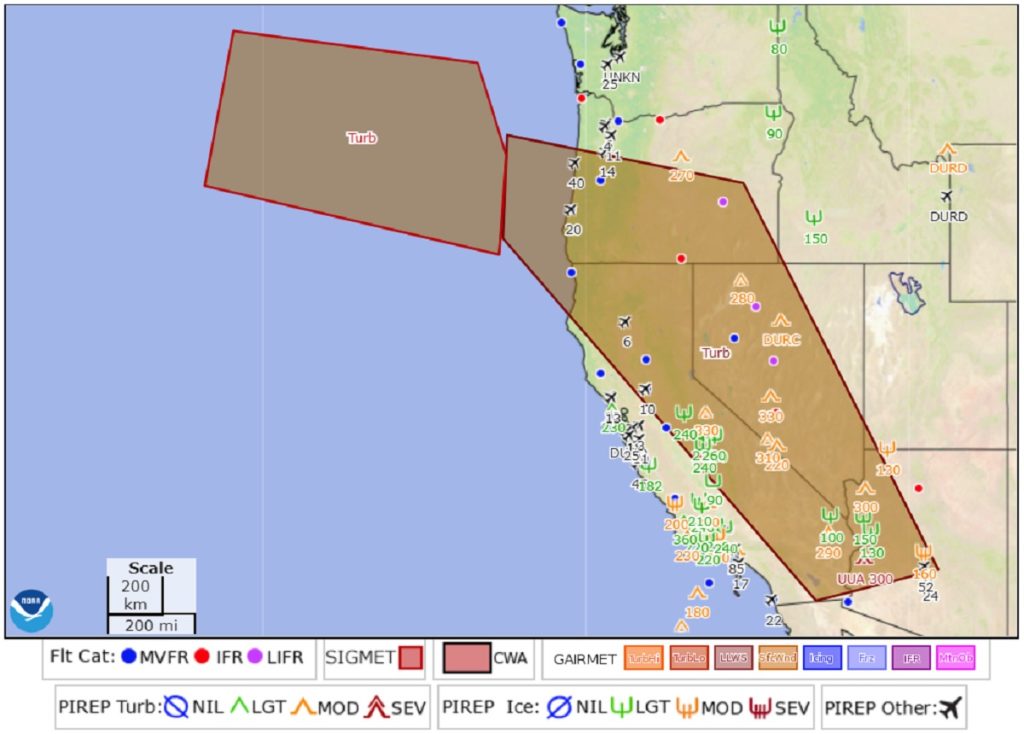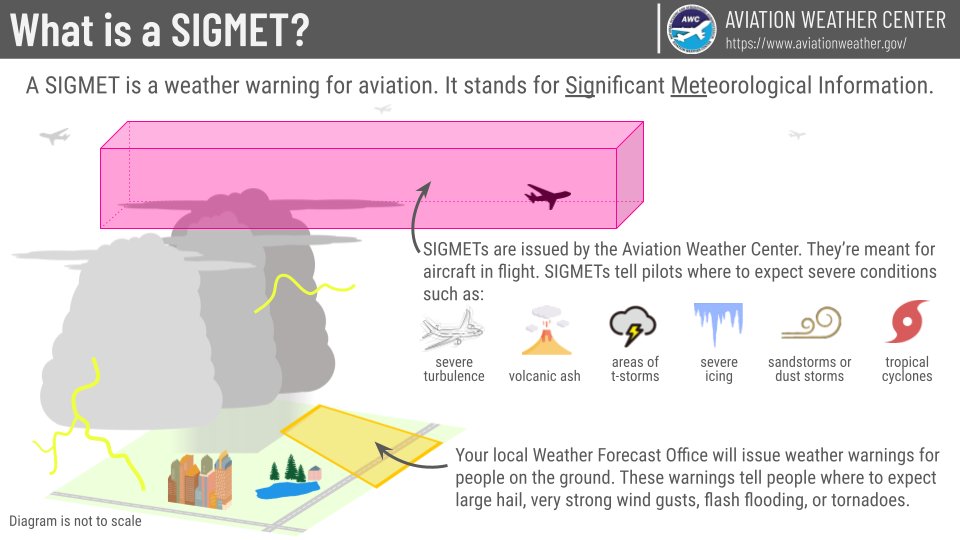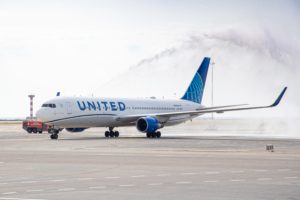
The National Weather Service’s Aviation Weather Center (AWC) has issued two alerts for severe turbulence in portions of the U.S. West and U.S. West Coast. While one alert is up for the off-shore waters west of Oregon and Washington, the other covers most of southern Oregon, large portions of California and Nevada, and parts of western Arizona.
Air travel in and out of Las Vegas’s McCarran Airport (LAS) is one example of many airports being impacted by this alert. Air travelers coming from the east into west coast cities such as Portland (PDX), San Francisco (SFO), Los Angeles (LAX), and San Diego (SAN) would also be impacted by this alert as well as all east-bound flights from those cities. Additionally, travelers flying to/from Hawaii (OGG/LIH/HNL/ITO/KOA) to places like Seattle (SEA) could also encounter this severe turbulence.


Specifically, SIGMET QUEBEC 5 has been issued through at least 2206Z tonight for the warned area over land and SIGMET DELTA 10 has been issued through at least 2205Z tonight for the warned area over water.
According to the AWC, there is occasional severe turbulence between 24,000 and 36,000 feet in the land-based portions of the wind, which was due to wind shear associated with the jet stream. The alert for the airspace over the ocean is for altitudes of 21,000 feet to 31,000 feet.
Wind shear is a difference in wind speed and/or direction over a very short distance in the atmosphere. Airline pilots generally regard significant wind shear to be a horizontal change in airspeed of 30 knots (15 m/s or 34 mph) for light aircraft and 45 knots (23 m/s or 51 mph) for traditional airliners flying at flight altitude.
Flying through turbulence can be dangerous, with injuries encounter on two U.S. airline flights last week.
A week ago Monday, a United Airlines 767 jet encountered severe turbulence on its flight to Houston, Texas. Due to that encounter with rough air, 3 crew members and 2 passengers had to be rushed to the hospital for care upon landing.

The day before, on December 18 , Hawaiian Airlines Flight 35 flew through severe turbulence before landing at Honolulu International Airport after originating in Phoenix, Arizona. A Mass Casualty Emergency Event was declared, with dozens of passengers needing care for injuries sustained in the violent ride. Officials with Honolulu Emergency Medical Services and American Medical Response say the flight encountered the extreme turbulence about 30 minutes prior to landing; they treated 36 patients at the airport. 20 patients, ranging from a 14-month old toddler to older adults, were transported to hospitals near the airport, some with serious injuries.
Known as a SIGMET, short for Significant Meteorological Information, the severe weather advisory issued by the AWC contains weather-related information concerning the safety of all aircraft passing through a specific zone. Sometimes AIRMETs are issued too; an AIRMET consists of turbulence, visibility, and icing-related warnings that are less severe than those in a SIGMET.
The location of these SIGMETs is also bad news for Southwest Airlines which is struggling to restore it’s operations after extreme disruptions around the time the Bomb Cyclone moved through the United States in the days before Christmas. According to flight tracking website FlightAware, there are 2,490 flight cancellations so far today with flights that are within, into, or out of the United States; 2,458 of those are Southwest flights, which not only represent a majority of U.S. cancellations, but also 58% of their operations.
“Southwest’s flight delays & cancellations are beyond unacceptable,” Vermont Senator Bernie Sanders tweeted Wednesday. “This is a company that got a $7 billion taxpayer bailout & will be handing out $428 million in dividends to their wealthy shareholders.” The co-chair of Sanders’ 2020 presidential campaign, Nina Turner, also blamed Transportation Secretary Pete Buttigieg for Southwest problems this week, not the airline. “What’s happening with the railroads, airlines & the supply chain is a result of a small city mayor being made the Secretary of Transportation as a means to pad his resume for President,” she tweeted Tuesday. “Secretary Buttigieg is a prime example of failing up.”
Todays’ turbulence will impact most U.S. airlines service in the western United States, but especially Southwest which operates normally a high density of air traffic in its namesake region.
Pilots are encouraged to fly around or above this rough air while passengers are encouraged to always fasten their seatbelt while on an airplane –even when the seat belt sign isn’t on. When the sign to fasten seat belts is on, it’s a violation of federal law to ignore it. 14 C.F.R. 121.317(f) states that an airplane passenger “shall fasten his or her safety belt about him or her and keep it fastened while the ‘Fasten Seat Belt’ sign is lighted.” The statutory basis for the rule is 49 U.S.C. § 44701, which allows the FAA to issue “regulations and minimum standards for . . . practices, methods, and procedure the Administrator finds necessary for safety in air commerce.” However, the violation is civil, not criminal. The applicable penalty provision is 49 U.S.C. § 46301(a)(5)(A), which authorizes “a civil penalty of not more than $10,000” for violations of “a regulation prescribed . . . under” 49 U.S.C. § 44701.